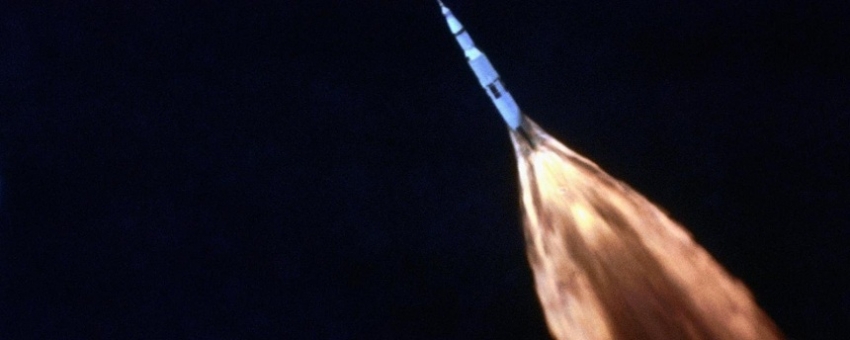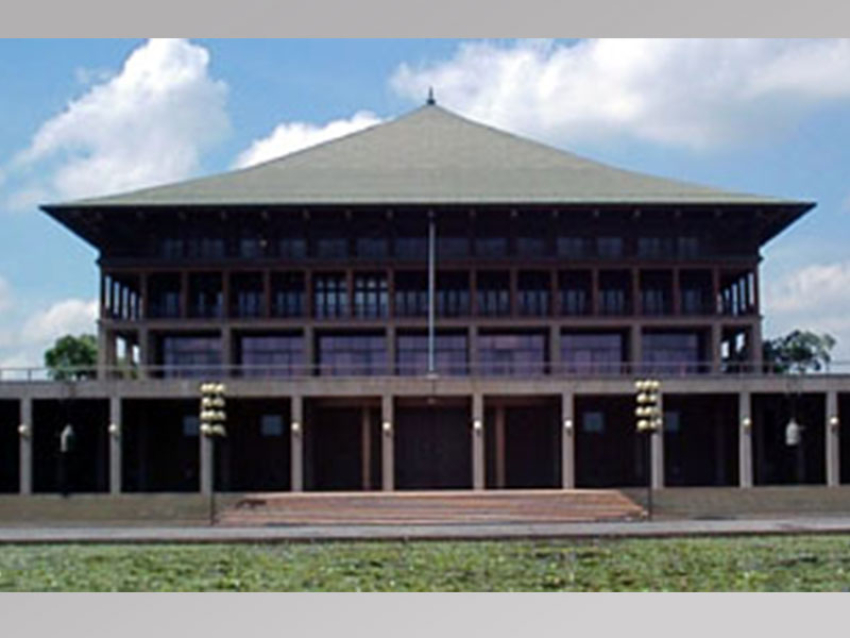Computer technology was one of the greatest – and long lasting – achievements of Apollo. From the solid-state microcomputer fitted to the lunar lander, to mighty IBM mainframes, with their flashing lights and banks of magnetic tape.
To navigate the Apollo spacecraft the quarter of a million or so miles to the Moon and then descend to a precise spot on the surface, astronauts used the Apollo Guidance Computer (AGC).
Housed in a box around the size of a small suitcase, with a separate display and input panel fitted to the main spacecraft console, it was a masterpiece of miniaturisation.
Developed by the Massachusetts Institute of Technology (MIT), the AGC was filled with thousands of integrated circuits, or silicon chips. Nasa’s order of this new technology led to the rapid expansion of Silicon Valley and accelerated the development of today’s computers.
You might also like:
How many marathons to the Moon?
Designing a diet for Moonwalkers
The giant rocket for a mighty mission
Although the 74 KB ROM and 4 KB RAM memory of the AGC sounds puny today – the equivalent of a 1980s home computer such as the Sinclair ZX Spectrum or Commodore 64 – it was an impressive machine. Designed for the rigours of spaceflight, its software was hard-wired into coils and, crucially, it was set up so it couldn’t crash.
Meanwhile on the ground in the Manned Spacecraft Center in Houston, Nasa bought five of the latest IBM 360 computers to analyse, in real time, every aspect of the spacecraft’s speed, trajectory and health. The system included provision for a standby computer in case one of them failed at a crucial moment.
Despite the vast computing power behind Apollo, some technology would have been familiar to 19th Century explorers. In the days before pocket calculators, astronauts made simple calculations using slide rules and to aid navigation, they took sightings of the stars with sextants.
1202: Computer alarms
Just five minutes after Neil Armstrong ignited the descent engine on the lunar lander, the first of several 1202 and 1201 alarms sounded in his headset.
“Program alarm…it’s a 1202,” Armstrong reported.
Buzz Aldrin on the Moon (Credit: Getty Images)
The Apollo 11 astronauts journeyed to the Moon with the aid of a computer with as much memory as a 1980s computer like the Commodore 64 (Credit: Getty Images)
Neither he nor Capcom Charlie Duke knew what the alarm means. The tension in their voices betrayed the fear it could lead to the first Moon landing being called-off.
But in Houston, mission controllers had seen a similar warning a few days earlier in simulations.
“We were low to the surface of the Moon and the computer got very busy,” says Apollo flight director Gerry Griffin. “The alarms were saying: ‘Hey guys I'm overworked a little bit.’”
Quote: The Apollo Guidance Computer wasn’t the only miracle of miniaturisation in the Apollo spacecraft
Calmly looking at the data on his console, guidance officer Steve Bales gave the go-ahead to continue.
“I found out later that they actually had intended those alarms to be a priority seeker, so if the computer got really busy it would start putting aside things that really didn't need to be calculated,” says Griffin. “The alarm says, ‘Hey I'm too busy and I just kicked off some stuff’, so they continued their descent.”
“You had people on the ground not only in mission control, we had the MIT people online listening to the same conversations we were. We couldn't have done it just with the 20 guys or so in the control room and the three astronauts – we had a lot of help, it was a big team effort.”
9: Number of cassette players flown
The Apollo Guidance Computer wasn’t the only miracle of miniaturisation in the Apollo spacecraft. Crews also carried early versions of Sony Walkman portable cassette recorders.
Originally intended for the astronauts to record personal observations, they were also able to take their own music mix tapes.
Glenn Campbell (Credit: Getty Images)
Country singer Glenn Campbell's music was played in space by astronaut Charlie Duke (Credit: Getty Images)
While the youngsters in mission control might be listening to the latest track by the Beatles, most astronauts – who were a good 10 years older – tended to prefer easy listening and country selections. Apollo 17 commander Gene Cernan, for example, chose music by Frank Sinatra and Glenn Campbell.
Rusty Schweickart’s Apollo 9 mission was the first to carry cassettes. His crewmates chose a typical selection of country, but he plumped for classical pieces he had listened to at home.
Quote: It was just unbelievable, that music came on and it was so powerful it jerked me out of that spaceship in orbit around the Earth - Rusty Schweickart
“Every Sunday evening, after I had put the kids to bed, I would sit in the living room with a desk lamp, just creating a circle of light around me on the floor and I would play the music on the stereo as I would look through a series of writings and quotations I took up with me,” Schweickart told the BBC World Service programme 10,9,8,7.
But once in orbit, the astronaut’s cassette was nowhere to be found.
“Dave Scott miraculously, on the ninth day of our 10-day mission, found that tape: ‘Oh Rusty is this what you’ve been looking for?’” Schweickart says. “I gave them the bird frankly and put my tape in the Walkman and said I’m just going to enjoy my music while you guys take care of the flight, to heck with you.
“It was just unbelievable, that music came on and it was so powerful it jerked me out of that spaceship in orbit around the Earth, right back to those very, very personal quiet evenings in my home in Houston. It was so powerful, I literally turned the music off, it was an incredibly powerful emotional experience.”
(You can read more about space music here)
36: Weight of satellite launched by Apollo, in kilograms
If having two spacecraft in orbit around the Moon – the command module and lander – wasn’t enough, with Apollo 15, Nasa planned to add another. Apollo 15 was the first of the agency’s J-class missions and as well as the first lunar rover, it featured a souped-up command module with an equipment bay on the side. This was packed with experiments to study the Moon from lunar orbit.
Saturn V computer (Credit: Nasa)
The Saturn V's computer was probably the largest computer ever blasted into orbit (Credit: Nasa)
One of the last of these experiments to be deployed was another spacecraft - a 36kg (79lb) hexagonal satellite. Designed to remain in orbit around the Moon for a further year, it would send back data on gravity, charged particles and measurements of the Earth’s magnetic field.
Just before returning home, on the 74th orbit of the Moon, the crew of Apollo 15 prepared to release the spacecraft.
Quote: The satellite sent data back to Earth for around six months before failing
Arming the mechanism, in true Nasa tradition, Dave Scott gave a countdown before flicking a switch to send the satellite spinning out of the equipment bay.
“Tally ho!” says Scott, as the satellite sprung out of the side of the service module.
“A very pretty satellite out there.”
The satellite sent data back to Earth for around six months before failing. It was succeeded by a near-identical satellite, launched by the crew of Apollo 16, in April 1972. Unfortunately, because it was launched into a low orbit, the second satellite only lasted six weeks before crashing into the lunar surface.
22: Diameter of Saturn V computer, in feet
If the Apollo Guidance Computer was impressive for its miniaturisation, then the computer controlling the Saturn V Moon rocket must rank as the largest ever launched.
Fitted within a ring above the top of the upper (third) stage of the rocket, the Saturn V instrument unit was massive. As well as digital and analogue computers, the unit contained all the electronics to control and monitor the rocket that would get men to the Moon.
Apolllo 15 crew with satellite (Credit: Nasa)
Apollo 15's crew launched a satellite which orbited the Earth for six months (Credit: Nasa)
Designed by Wernher von Braun’s rocketry team in Huntsville, Alabama, the computer was built by IBM. It was practically the equivalent of flying a mainframe computer into space and then abandoning it.
Despite being fitted with the latest solid-state silicon chip technology, the instrument unit’s gyroscopic guidance system – designed to keep the rocket on a stable trajectory – was based on technology von Braun had developed for his V2 missile in World War Two.
When Apollo 12 was struck by lightning during launch, knocking out power in the command module, mission controllers believe the circular design of the rocket’s computer saved it from the power surge.The supercomputer ejected into space




















